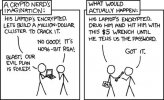Hello everyone,
I am looking for common thoughts on how plausible deniability is achieved in freebsd when using geli (or maybe zfs inline encryption) ?.
Coming from linux background, one would typically create efi, boot partition and store those on a usb stick or microSD.
Main drive would then be wiped and no partition would be created, raw disk would then be setup as encrypted disk with cryptsetup using aes-xts-plain64 with a password.
This would essentially make the main drive appear as a raw disk with no metadata, as required cipher params would be provided on the boot partition where they are initially configured in /etc/crypptab.
I am aware that there ways to attack this, such as evil maid, extracting keys from ram, as well as simple methods outlined in the attached comic, however in my opinion its better to have something than nothing. Nothing being metadata on disk giving away the use of encryption.
Wondering if anyone has done this in freebsd, let me know your thoughts, ideas on this.
I am looking for common thoughts on how plausible deniability is achieved in freebsd when using geli (or maybe zfs inline encryption) ?.
Coming from linux background, one would typically create efi, boot partition and store those on a usb stick or microSD.
Main drive would then be wiped and no partition would be created, raw disk would then be setup as encrypted disk with cryptsetup using aes-xts-plain64 with a password.
This would essentially make the main drive appear as a raw disk with no metadata, as required cipher params would be provided on the boot partition where they are initially configured in /etc/crypptab.
I am aware that there ways to attack this, such as evil maid, extracting keys from ram, as well as simple methods outlined in the attached comic, however in my opinion its better to have something than nothing. Nothing being metadata on disk giving away the use of encryption.
Wondering if anyone has done this in freebsd, let me know your thoughts, ideas on this.

